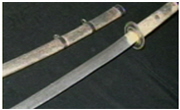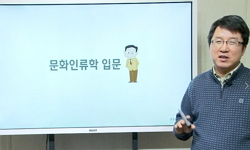This paper aims to understand the form and change of Butoh dance from the perspective of the body. Hijikata Tatsumi’s dark butoh has discovered the “materiality” of the body, including grotesque and self-killing, regression of the body toward th...
http://chineseinput.net/에서 pinyin(병음)방식으로 중국어를 변환할 수 있습니다.
변환된 중국어를 복사하여 사용하시면 됩니다.
- 中文 을 입력하시려면 zhongwen을 입력하시고 space를누르시면됩니다.
- 北京 을 입력하시려면 beijing을 입력하시고 space를 누르시면 됩니다.

부토에서 ‘육체’의 인식에 따른 춤 형태 연구 = A Study of Dance Forms Based on the Perception of the ‘Body’ in Butoh
한글로보기https://www.riss.kr/link?id=A107774833
- 저자
- 발행기관
- 학술지명
- 권호사항
-
발행연도
2021
-
작성언어
-
-
주제어
Butoh ; 부토 ; Perception of the ‘Body’ ; 몸의 인식 ; Materiality ; 물질성 ; Spirits ; 혼 ; Universal physicality ; 보편적 육체
-
등재정보
KCI등재
-
자료형태
학술저널
- 발행기관 URL
-
수록면
1-13(13쪽)
-
KCI 피인용횟수
0
- DOI식별코드
- 제공처
- 소장기관
-
0
상세조회 -
0
다운로드
부가정보
다국어 초록 (Multilingual Abstract)
This paper aims to understand the form and change of Butoh dance from the perspective of the body. Hijikata Tatsumi’s dark butoh has discovered the “materiality” of the body, including grotesque and self-killing, regression of the body toward the darkness of the source, and fall. In the case of Ohno Kazuo, the spirits of the dead are accepted by his body, and his dances presented mainly improvised, entertaining, colorful, and dynamic movements by combining various opposite entities. The next generation, including Shankai Juku, is showing a different physicality from the previous generation. It shows the pursuit of "universal physicality" rather than individuality, or “physical retreat,” which is approaching universality by carving and refining the special form of dark Butoh with internationalization.
참고문헌 (Reference)
1 이재인, "히지카타 타츠미의 암흑 부토와 일본인 신체" 한국연극학회 1 (1): 101-123, 2019
2 김태원, "후기 현대 춤의 미학과 동향" 현대미학사 1992
3 고은숙, "초기 부토의 반 예술적 특징" 15 (15): 47-58, 2015
4 장인성, "전후 일본의 보수와 표상" 서울대학교 출판문화원 2010
5 아카세가와 겐페이, "일본의 실험미술" 시공사 2001
6 김용철, "일본 부토를 통해 본 한국창작무용의 과제" 26 (26): 143-165, 2008
7 오카모코 타로, "오늘의 예술" 눌와 2005
8 김태원, "어느 (부토) 댄서의 고민" 50 (50): 147-, 2005
9 폴 발레리, "신체의 미학" 현대미학사 1997
10 이명진, "부토와 비교를 통한한국창작무용의 정체성 연구" 22 : 105-116, 1997
1 이재인, "히지카타 타츠미의 암흑 부토와 일본인 신체" 한국연극학회 1 (1): 101-123, 2019
2 김태원, "후기 현대 춤의 미학과 동향" 현대미학사 1992
3 고은숙, "초기 부토의 반 예술적 특징" 15 (15): 47-58, 2015
4 장인성, "전후 일본의 보수와 표상" 서울대학교 출판문화원 2010
5 아카세가와 겐페이, "일본의 실험미술" 시공사 2001
6 김용철, "일본 부토를 통해 본 한국창작무용의 과제" 26 (26): 143-165, 2008
7 오카모코 타로, "오늘의 예술" 눌와 2005
8 김태원, "어느 (부토) 댄서의 고민" 50 (50): 147-, 2005
9 폴 발레리, "신체의 미학" 현대미학사 1997
10 이명진, "부토와 비교를 통한한국창작무용의 정체성 연구" 22 : 105-116, 1997
11 이재인, "부토보(舞踏譜) 분석을 통한 히지카타 타츠미의 암흑부토 연구" 무용역사기록학회 51 : 149-169, 2018
12 심정민, "부토를 통한 아시아 현대 춤의 세계화 가능성" 50 (50): 46-53, 2005
13 김영옥, "부토(舞踏)의 육체성과 그 미학에 관한 연구" 중앙대학교 대학원 2000
14 大野一雄, "舞踏とぃぅ表現方法" 6 : 55-, 1992
15 郡司正勝, "破戒のなかの婚儀-舞踏への行衛につぃて" 4 : 44-, 1977
16 古澤俊美, "石井滿隆-狂氣·快樂·死を化術として" 6 : 80-, 1970
17 合田成男, "手の變幻" 8 : 34-, 1977
18 城戶朱理, "大野一雄舞踏譜" 思潮社 1992
19 三上貿代, "器としての身體-土方巽·暗黑舞踏技法へのァプロ-チ" ANZ堂 1993
20 Brunel, Lise, "Kazuo Ohno au Théátre du Lierre Iles de Danse-Simplicité GénérositéHumanité"
21 한명옥, "Hijikata의 부토댄스" 12 : 21-35, 1992
22 Laage, Joan Elizabeth, "Embodying the Spirit: The significance of the body in the contemporary Japanese dance movement of Butoh" Woman’s University 1993
23 Oosuka Isamu, Daniel De Bruycker, "Danser les vagues de jadis aucoeur de la forȇt" 22-23 : 79-, 1985
24 Viala, Jean, "Butoh: Shades of Darkness" Shufunotomo Co 1988
동일학술지(권/호) 다른 논문
-
펠든크라이스 ATM® (Awareness Through Movement)방식이 무용수의 신체자각 능력에 미치는 영향에 관한 연구 - 대학 3년 현대무용 전공생을 중심으로 -
- 한국무용예술학회
- 서채린 ( Seo Che-rin )
- 2021
- KCI등재
-
윌리엄 포사이드 작품의 초현실주의 표현기법 분석 - 「추상화된 도시」, 「흩어진 군중」, 「헤테로토피아」를 중심으로 -
- 한국무용예술학회
- 안현민 ( Ahn Hyunmin )
- 2021
- KCI등재
-
노장사상의 무(無)사유형식을 적용한 무용창작작품 「현해(玄海)」의 공간 연구
- 한국무용예술학회
- 이은정 ( Lee Eun Jung )
- 2021
- KCI등재
-
- 한국무용예술학회
- 정수동 ( Jung Soo Dong )
- 2021
- KCI등재
분석정보
인용정보 인용지수 설명보기
학술지 이력
| 연월일 | 이력구분 | 이력상세 | 등재구분 |
|---|---|---|---|
| 2027 | 평가예정 | 재인증평가 신청대상 (재인증) | |
| 2021-01-01 | 평가 | 등재학술지 유지 (재인증) |  |
| 2018-01-01 | 평가 | 등재학술지 유지 (등재유지) |  |
| 2015-01-01 | 평가 | 등재학술지 유지 (등재유지) |  |
| 2014-10-22 | 학회명변경 | 영문명 : 미등록 -> The Korean Society for Dance Studies |  |
| 2011-01-01 | 평가 | 등재학술지 선정 (등재후보2차) |  |
| 2010-01-01 | 평가 | 등재후보 1차 PASS (등재후보1차) |  |
| 2009-01-01 | 평가 | 등재후보 1차 FAIL (등재후보2차) |  |
| 2008-01-01 | 평가 | 등재후보 1차 PASS (등재후보1차) |  |
| 2007-01-01 | 평가 | 등재후보학술지 유지 (등재후보2차) |  |
| 2006-01-01 | 평가 | 등재후보 1차 PASS (등재후보1차) |  |
| 2004-01-01 | 평가 | 등재후보학술지 선정 (신규평가) |  |
학술지 인용정보
| 기준연도 | WOS-KCI 통합IF(2년) | KCIF(2년) | KCIF(3년) |
|---|---|---|---|
| 2016 | 0.51 | 0.51 | 0.53 |
| KCIF(4년) | KCIF(5년) | 중심성지수(3년) | 즉시성지수 |
| 0.51 | 0.52 | 0.698 | 0.29 |





 KCI
KCI KISS
KISS





